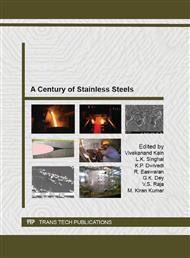[1]
K.A. Natarajan, Microbes, Minerals and Environment, Geological survey of India, Bangalore (1998).
Google Scholar
[2]
K.A. Natarajan, Microbially – influenced corrosion, in, U.K. Mudali and Baldev Raj (Eds), Corrosion Science and Technology, Narosa, New Delhi 2008, pp.95-121.
Google Scholar
[3]
K.A. Natarajan, Advances in corrosion engineering, Web course under NPTEL (www. nptel. iitm. ac. in).
Google Scholar
[4]
S.W. Borenstein, Microbiologically influenced corrosion handbook, Wood head Pub. Ltd., Cambridge (1994).
Google Scholar
[5]
C.C. Gaylarde, H.A. Videla, (Eds), Bioextraction and Biodeterioration of metals, Cambridge Univ. Press, Cambridge (1995).
Google Scholar
[6]
H. A. Videla, L. K. Herrera, Microbiologically influenced corrosion: looking to the future. Research Review. International Microbiology 8 (2005) 169-180.
Google Scholar
[7]
I. B Beech, C.C. Gaylarde, Recent advances in the study of biocorrosion an overview, Rev. Microbiol, 30 (1999) 1-22.
DOI: 10.1590/s0001-37141999000300001
Google Scholar
[8]
K.R. Sreekumari, K. Nandakumar, Y. Kikuchi, Bacterial attachment to stainless steel welds: Significance of substratum microstructure, Biofouling, 17 (2001) 303-316.
DOI: 10.1080/08927010109378490
Google Scholar
[9]
R.K. Singh Raman, Interplay of microbiological corrosion and alloy microstructure in stress corrosion cracking of weldments of advanced stainless steels, Sadhana, 28 (2003) 467-473.
DOI: 10.1007/bf02706444
Google Scholar
[10]
H. Men, C. H. Wang, Y. Peng, S. R. Yang, Z. M. Xu, Biocorrosion induced by sulfate reducing bacteria on stainless steel-A preliminary study, Proc. Int. Conf. Heat exchanger fouling and cleaning, Schladming, Austria, (2009).
Google Scholar
[11]
J. Landoulsi, K. E. Cooksey, V. Dupres, Review-Interactions between diatoms and stainless steel; focus on biofouling and biocorrosion, Biofouling, 27 (2011) 1105-1124.
DOI: 10.1080/08927014.2011.629043
Google Scholar
[12]
L. Landoulsi, K. Elkirat, C. Richard, D. Feron, S. Pulvin, Enzymatic approach in microbial- influenced corrosion: A review based on stainless steels in natural waters, Environ. Science, Technol., 42 (2008) 2233-2242.
DOI: 10.1021/es071830g
Google Scholar
[13]
C. Marconnet, C. Daghert, M. Roy, D. Feron, Stainless steel ennoblement in fresh water: from exposure tests to mechanisms, Corrosion Science, 50 (2000) 2342-2352.
DOI: 10.1016/j.corsci.2008.05.007
Google Scholar
[14]
W.H. Dickinson, F. Caccavo, Z. Lewandowski, The ennoblement of stainless steel by manganic oxide biofouling, Corrosion Science, 38 (1996) 1407-1422.
DOI: 10.1016/0010-938x(96)00031-5
Google Scholar


